|
|
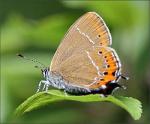
|
Black Hairstreak
|
|
Special features: The uppersides of the wings are mostly brown. The male black hairstreak has some orange spots on the back edge of the hind wings. There is also a bluish scent patch on the forewings. The female black hairstreak has some additional orange spots on the forewings. |
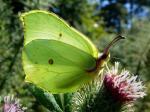
|
Brimstone Butterflies
|
|
Special features: Brimstone butterflies are often the first and last butterflies seen in the UK each year. They go into hibernation around October time and emerge on the first sunny spring days in February or March. |
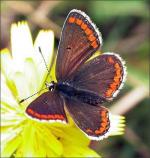
|
Brown Argus
|
|
Special features: The upper surface of the wings are dark brown with a row of orange half-moons all around the edges and a narrow white border. There in a black spot in the centre of each forewing. |
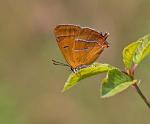
|
Brown Hairstreak
|
|
Special features: The brown hairstreak is the largest of our native hairstreak butterflies. |
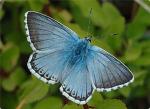
|
Chalkhill Blue
|
|
Special features: The wings of the male Chalk-hill blue are a much paler blue than those of the common blue. They appear almost silver-blue with a dark margin. The upper surfaces of the female's wings are brown coloured. The white borders of both male and female wings are chequered with dark lines. |

|
Clouded Yellow
|
|
Special features: The clouded yellow is a migratory butterfly from Europe which usually settles in the southern counties. When winter comes the adults either die or migrate south. |

|
Comma
|
|
Special features: Only 100 years ago this ragged looking butterfly was almost extinct in Britain. The reason for its decline is still a mystery, but from 1830 to 1920 sightings in the southern counties of England were reduced to just one or two. It wasn't until around 1930 that numbers started to increase. Today the comma is a familiar sight in southern England and Wales. |

|
Common Blue
|
|
Special features: On sunny days you can sometimes find these butterflies feeding together in small colonies. It's the most commonly seen of all the blue butterflies. |
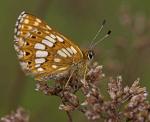
|
D of B Fritillary
|
|
Special features: The Duke of Burgundy Fritillary is a brown coloured butterfly with orange spots and a broken white border. |
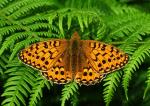
|
Dark Green Fritillary
|
|
Special features: The dark green fritillary gets its name from the olive-green patches, dotted with pearly-white spots, on the undersides of its wings. |

|
Dingy Skipper
|
|
Special features: Could easily be mistaken for a moth, especially when it rests with its wings in a roof-like position - like a noctuid. |

|
Essex Skipper
|
|
Special features: Frequently confused with the Small skipper as they do look very similar. The easiest way to tell them apart is to sneak up on one, or net one, and look closely at the undersides of the antennae tips. The Small Skipper has an orange tip, while the Essex Skipper has a black tip. |
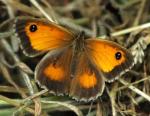
|
Gatekeeper
|
|
Special features: Sometimes called the 'hedge brown'. The gatekeeper has orange wings with a thick brown border. In the corner of the forewings is a black dot with two white dots inside it. On the hindwings is a smaller black dot with one white dot inside it. |
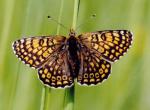
|
Glanville Fritillary
|
|
Special features: Named after Eleanor Glanville, the 18th century amateur naturalist. The hind wings feature a row of black dots inside orange spots which make it distinctive from similar species like the Marsh Fritillary. |

|
Grayling
|
|
Special features: The grayling is the largest brown butterfly in the UK. There are two black eye spots on each forewing which can be seen on the upper and lower surfaces. The spots have a white dot in the centre. The males have a dark brown border on the leading edge of the forewings. This releases a scent during courtship. |
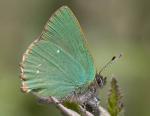
|
Green Hairstreak
|
|
Special features: This is the only butterfly to have completely green coloured scales on the undersides of its wings. The upper surfaces of the wings are brown. |
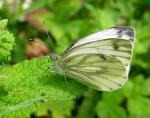
|
Green Veined White
|
|
Special features: At first glance this looks like a small white butterfly. On closer inspection, when it is resting, you can see the green lines on the underside of the wings which give this butterfly its name. |
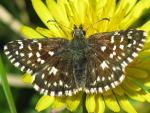
|
Grizzled Skipper
|
|
Special features: Can be distinguished from other similar species by the row of white square patches around the outer edge of the hind wing. |

|
Heath Fritillary
|
|
Special features: The Heath Fritillary is one of the most endangered butterflies in the UK. Their flight is weak and fluttery, and their range is small, so they usually remain in one place.&nbnsp;Consequently when their habitat disappears so does their colony. |
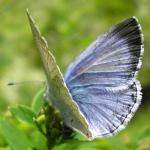
|
Holly Blue
|
|
Special features: If you see a blue butterfly in your garden, it's most likely to be the Holly Blue. It's the only blue butterfly which is regularly seen in gardens. |
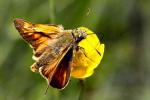
|
Large Skipper
|
|
Special features: At rest, the large skipper assumes a moth-like stance, with its forewings and hind wings held apart at different angles. |
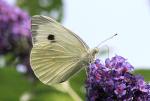
|
Large White
|
|
Special features: The UK population is swelled each year by swarms of large whites arriving from Europe. |

|
Lulworth Skipper
|
|
Special features: The upper wings feature a golden coloured 'C' shaped marking. |
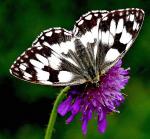
|
Marbled White
|
|
Special features: The only British butterfly with these distinctive markings. It is a black butterfly with white markings. |
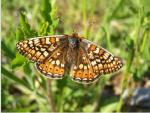
|
Marsh Fritillary
|
|
Special features: The Marsh fritillary population has declined in the U.K. due to loss of habitat. They are slow flyers and breed in the same areas each year. As their meadow homes were drained, or ploughed up, many colonies disappeared. |
|
|